Sword of the Stars Review
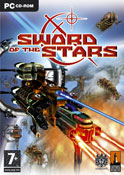
| Developer: | Kerberos Productions |
| Publisher: | Lighthouse Interactive |
| Genre: | 4X turn based strategy |
| Platform: | PC |
| Official Site: | http://www.kerberos-productions.com/sots.shtml |
| Release Date: | September 8th, 2006 (UK) |
| Reviewer: | James Barlow (Malis) |
| Buy now at Amazon.co.uk | |
Leonardo Da Vinci once famously declared that simplicity is the ultimate sophistication, and in this age of minimalism we very much seem to have taken this to heart. Sleek, simple concepts and a back-to-basics approach typify many modern designs - just look at Apple. It's no surprise then, that developers Kerberos Productions have applied this doctrine to their latest 4X turn-based space strategy title, Sword of the Stars. Using a simple UI and eliminating much of the reams of statistical information we've come to expect with such a game, Kerberos have attempted to make an intuitive, non-intimidating strategy game.
This approach is immediately obvious from just the options screen. There's no story to Sword of the Stars, no reams of dialogue to sit through or history to browse. Sure, there are a handful of scenarios that you can jump into, but most of your game-time will be spent in the sandbox world of the custom game. In some ways this is a refreshing and honest approach to strategy games - I can't be the only one who finds it incredibly annoying that in story-driven strategy games you have to go back to the drawing-board at the start of each new mission. Predictably, setting up a custom game is as simple as choosing one of the four races (Humans, Hivers, Tarkas and Liir) and a universe size, then starting up
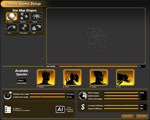
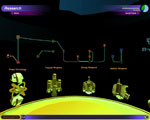
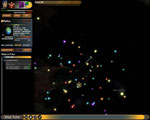
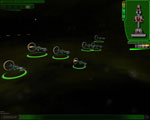
Game-play in Sword of the Stars is spread over two areas, the first being the strategic mode. It's here that you'll spend the bulk of your time, managing your colonies and conducting research. As promised, the UI is a stream-lined simple affair. Click on a planet or colony and it shows you the relevant details with population and industrial output. However there's no further micromanagement required for your colonies, other than slider management. If you want to increase output from a planet, you just slide towards trade, if you want faster ship construction, you just slide towards construction. It's really that simple. On newly colonised worlds you'll get a couple more sliders to determine how fast industry and population initially grow, but other than that colonies look after themselves. So, once you've spent all of two seconds in your turn thinking about sliders, it's generally time crack the whip and get your scientists researching.
A fully rotatable visual experience, the research tree is a refreshing change from bland text-laden mazes we're normally accustomed to, and probably the game's greatest feature At the click of a button you can see exactly what a technology does and see just how it inter-connects with all the other trees. In a nice touch, Kerberos have made the technology trees random each game, so you can't rely on the same research routes every game. Once you've selected a tech to research (everything from lasers to gene modification), you assign how much of your budget you want to allocate towards it (using, you've guessed it, a slider). Techs cover a broad area, but many of them are geared towards upgrading and powering your ships. Research the right areas and you'll be given new ship parts to use in construction.
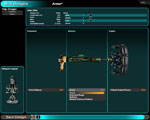
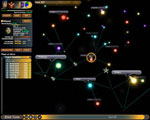
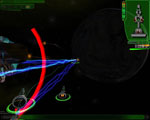
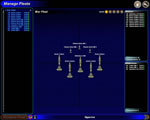
Like Galactic Civilizations 2, Sword of the Stars allows the player to construct ships from the ground up. While nowhere near as detailed as GalCiv, it remains an entertaining diversion. Ships are divided into 3 modules; Command, Mission and Engine. Mixing and matching these with different weapons allows for some degree of player customization. Of course, special modules allow for special abilities. Colony modules for example, allow you to colonise worlds but have little weapon slots or armour, while the tanker module allows you to construct refuel ships. Once you've designed a ship and built it, you can plot a course for fleet movements
It's in ship movement that much of Sword of the Stars' depth comes to light. Each of the four races bring very different approaches to interstellar travel. The Humans, being fairly efficient, have developed the Node Drive that allows them to travel in pre-set lines between planets at a reasonably fast speed. Think London Underground featuring planets (without delays). Hivers move slowly, but once they reach a planet can drop a warp gate allowing for ultra-fast travel in the future. Tarkas and Liir are more familiar in travel methods, with average speeds unlimited by direction. Using the differing advantages of each race's methods of travel becomes important as you race to control the galaxy.
Of course, explore enough of the galaxy and you're bound to get some unwanted attention. There's little room for diplomacy in Sword of the Stars, mostly due to a frustratingly rudimentary system that's in place. Though it does allow you to trade or make alliances, there's little of the interaction associated with other titles in the genre. With little economy management actually required, it's clear that the real meat and focus of the game is on combat.
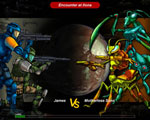
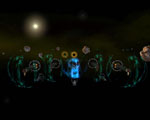
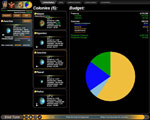
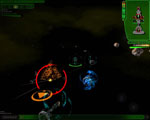
And combat does look good. Seeing your ships line-up and batter into the enemy lines looks both impressive and almost cinematic. You can issue movement and attack commands and your fleet will instantly respond, barking an acknowledgement over comms before launching a missile barrage. Yet for all it's visual excitement, the actual mechanics of fighting are quite frustrating. The camera remains focused on your currently selected ship, which can lead to some quite frustrating moments of trying to find out where the action is and view it. There's no interface read-outs of how damaged ships are, instead you must rely on on visual and aural indicators. While a nice idea, it's both clumsy and inadequate at times. What's worse is when an enemy attacks an undefended planet. You're then forced to watch enemy ships fly towards your planet (often you won't see them though, due to the aforementioned camera niggles) whilst your colony lets loose a missile every so often. With no way to quit or skip combat (you can't even exit game in combat), the player is often forced to watch 2 minutes of empty space.
Ultimately, the player finds themselves helpless to actually influence combat other than initially deciding targets. For a game so stream-lined in it's economy management, it seems odd that combat hasn't been fleshed out as a more hands-on experience. Speaking of hands-on, special mention must be made of the star map where you'll manage your planets. Fully 3D and bursting with colour, it's undoubtedly pretty, if a little unwieldy to use due to both 3D nature and a poor camera (again the camera remains fixed around a planet until you select another). Graphics during combat are also effective, though nothing ground-breaking. The cartoon-style visual design of the game is a welcome change, and one in keeping with a less serious and less complicated strategy title.
Sword of the Stars also comes complete with a multi-player mode that is fairly robust. This is mostly down to the AI system, whereby you can drop out of the game if you need to have a shower or make dinner, and the AI will continue playing for you. One interesting touch is the fact you can't communicate with your opponent in chat until you meet them and research their language. Whilst a nice idea, I'm not totally convinced - if you're just playing 1 on 1, it can take upwards of an hour before you first meet your enemy if you both happen to play slower game styles. All in all it's a nice way to round out the game, but I'm still not of the opinion that any turn-based strategy can offer truly compelling multi-player.
Summary
It's clear that Kerberos have succeeded in creating a more simple, user-friendly version of the 4X turn-based strategy game. Despite some annoyances with combat and using the star map, the game is robust and has some nice ideas. So what's the problem? Simply put, I'm not sure who this game is for. I feel it's far too basic and simplified for the hardcore turn-based strategy fan, especially when compared to the recent Galactic Civilizations 2. There's simply not enough to do when you're not fighting. If you're not normally a fan of the genre, it's difficult to see if this is enough to draw you in. If you're going to take the plunge into 4X strategy, you might as well go the whole way and be prepared to look over a few stat sheets. Just as Leonardo Da Vinci had something to say on simplicity, so too did Einstein, who claimed; everything should be made as simple as possible, but not simpler. If Sword of the Stars had stream-lined its exterior and retained some more depth under the hood for those who were prepared to look, we might have a great game. As such, Sword of the Stars is merely a solid example of the genre.
Good stuff
- Simple and stream-lined interface
- Great research tree
- Combat can become quite cinematic
- Robust multi-player
Not so good stuff
- Frustrating star map
- Combat can be annoying at times
- Sometimes feels too simple
Things You Should Buy Just After You Move Into New House
Packers and Movers Chennai Are the Best At Such An Affordable Price
Guide For Packing Up The Master Bedroom In An Organized Way
Girls Are You Packing For College? Then You Need To Read These Tips First.